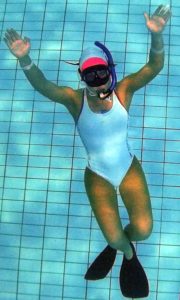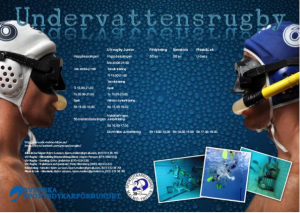What makes a good coach?
There is very little literature on the topic of training UWR, most clubs build their training on the base of trial and error and try to learn the methods of other clubs. This training concept may be helpful for new clubs in developing their own training methods.
UWR requires top swimming skills, fitness, and endurance.
This training concept assumes that players already have sufficient swimming skills. If not, trackback to earlier posts about swimming and finswimming.
Pool time is often expensive and restricted, therefore it makes sense to work out in a gym together or individually in order to focus 100% on UWR skills when in the water.
The coach’s role is crucial in a team and it’s advantageous if functions are kept separate. Meaning a coach should not be the team’s manager or a player. In such cases, interests may be conflicting and the possibilities to resolve them are limited. Still, coaches tend to be players too, but it’s because professional coaches barely get educated about UWR and only players have sufficient knowledge about the sport. But keep in mind, a player-coach won’t be able to see through the training or instruct the players the same way as a person on the deck.
When selecting a coach, there are important mental aspects. The person should be accepted by the team and should be able to create a training concept and follow through with the execution. It is also a responsibility of the coach to maintain the motivation of the players and the team spirit of the team. Keep in mind, having a strong team spirit should not mean converting players into blind followers of their leader. Group behavior emerges anyway, a coach needs to pay attention to keep this on the right track. Barabási Albert-László calls this “collective intelligence”, which has a lot more to do with open communication and emotional intelligence than with the team’s sum of IQ points. Relying on collective intelligence, leaders can direct a team towards heaven and hell alike, and the destination can only be told much later as group behavior tends to silence inside criticism.
Good training is very effective. You never know how much pool time teams waste with dressing up, figuring out what to do and how, until you try a well-organized training. They have an uninterrupted flow. Exercises should be explained prior to training and routines should be built to shorten the time not spent with effective work. Having routines also allow the players’ progress to be tracked and compared.
One last thing before getting into the specific drills: coaches need to ensure the safety of the game and be prepared for accidents as much it’s possible. To have a basic understanding of anatomy and physiology is necessary anyway.
As long as there is no standard education of UWR coaches, neither any payment for those who are still willing to take on this role, all this could be a lot to expect from them. The huge difference between sein and sollen highlights the fields we need to work on.
This concept divides training sessions into 3 segments. The first segment is warm-up and UWR-specific swim training, the second is about the game drills, and the third is playing.
Swimming drills
Warm-up and stretching before entering the pool help to avoid injuries. After a few laps of swimming, you can vary the common swimming exercises like stroke-only or kick-only. Even better if you are doing exercises which can only be done together and/or in a diving pool.
After swimming on the surface, having the team line up and dive down to each lane crossing the pool prepares the cardio-vascular system for what’s to come. Doing it together urges rookies to try to keep up. Each lap should be started together.
Rookies often need to stop before they dive. Diving down smoothly while swimming should also be practiced.
It makes sense to make swimming a little competitive so players would push their limits. You can group players to race the groups and increase intensity without making the pool feel too packed. If you have 20 players at a training and they stand in 4 lines of 5 by one side of the pool to do 5 rounds there and back x times, not only they won’t hit each others’ arms and legs in the water, but they are practicing quick exchanges in and out of the pool at once.
Racing players from time to time provide feedback and a way to measure progress. One way to go is having players swim a course and measure the time. Longer courses show differences between players better, but it takes a while to measure everyone and the meantime others may be standing still. The other way to go is having the time fixed to see how many laps players could do… vertically. This can be done simultaneously regardless the number of the players and they just need to give a number at the end of the exercise, how many times they’ve managed to touch the bottom of the pool. This is an even better indicator of differences in fitness. Given the test time long enough (4-5 minutes), the result will show a wide range. Compared to swimming long laps underwater, this is a better way to increase endurance and breath-hold time. After all, UWR is not about who holds their breath longer, but who is able to be at the bottom to defend and score. It is also safer if you’re not practicing how to oppress your urge to breath, but how to keep calm and your pulse rate low, allowing to catch your breath quicker.
Keep in mind that you are not training for swimming competitions, but for UWR.
If the team has enough balls, feel free to hand one to each person even for the time of the swimming drills, so people can get used to the best practices of carrying them while keeping a streamlined pose.
Also, there is no reason to stick to straight lines when swimming. Instead, you can try to create a track with hula loops to incorporate tight turns left, right, up or down, just make sure the way to go is obvious for the players. Furthermore, players should swim on their sides and back too. Swimming at the bottom facing upwards is the safest way to deliver the ball to the opponent’s goal.
Before transitioning to game drills, you can create fun exercises too, for example having a player push another across the pool held by the feet, or doing a lap in constant rotation around the body axle, etc.
Game drills
Game drills focus either on ball skills or positioning.
Ball handling covers passing, snatching and scoring.
To practice passing, players form a circle and dive down in order to pass at the bottom. If a player doesn’t make it back on time from surfacing on, the circle shrinks until only 2-3 players are left. If there are many players or it’s not challenging enough for them anymore, feel free to add more balls to the rotation.
Pair players up to swim laps making a certain number of passes the teamtime. Again, these laps don’t need to be a straight line. In fact, it’s even better if the pairs are not passing sideways, but one swims on the surface and passes downwards to the other playing swimming along underneath. Then the one with the ball surfaces for air and to pass the ball down to the one who’s been swimming above.
Snatching the ball can be practiced one on one. If there are enough balls, line up players in 2 rows. Each pair has 1-1 attempts to keep the ball for a certain amount of time while being tackled. The lines rotate until everyone tried to snatch the ball from everyone.
Encourage defenders to do more than just squeezing the ball between their torso and arm, but to experiment, how they can keep the ball free and safe at the same time with moving it around, so they can pass during match situations. Locking the ball up is a straight way to scrums on the surface.
When practising scenarios with more people, don’t worry about creating uneven groups of 3.
Cat and mouse games train passing and snatching combined.
Be careful, the more people are in a drill, the less controlled a tackle will be. Harder to learn, easier to get injured.
Penalty shots tend to be so exciting that players barely need to be asked twice to practice this. But such one vs one situations are rare during matches. Unless you indeed want to practice for penalties, players should have only one attempt to score and that should be very quick and powerful. Make sure everyone understands the importance of leverage and knows how to lift a goalie without causing injuries.
If a team has lots of rookie players, it’s better to do the drills without real resistance, just to get the motions right first.
Positioning is more about tactics, but there are certain principles you should incorporate in the drills. When practicing scoring with 3-4 players, start from the surface and provide very limited time. Attackers are urged to score fast, defenders are urged to take their positions quickly.
Goalies should practice exchange on the goal.
If players start from different distances from the goal, attackers can see whether it’s better to try to catch the ball before it makes its way to the goal or to fall back and aid the defense.
In general, ask players to stay under the ball to get passes, between the attacker and the goal during defense, on the non-exchange side when attacking and close to each other at all times. Be aware of other players and pay extra attention to exchange partners.
The possible variations of these exercises are endless, but try not to over-complicate training. Just because you could train with holding a banana in one hand, doesn’t mean you should. Very soon you’ll have perfect sense which drills utilise skills one’d need at a match.
Playing UWR
The last segment is for playing. The team may have more or less fixed sides, which eliminates time for preparation, but takes away the chance to experiment with different tactics. A coach can set the 2 sides up differently every time or appoint 2 captains to pick their team one person after another, just needs to make sure players don’t waste too much time with getting in the right outfit. During the game, the coach also acts as a ref. Teams sometimes get surprised at tournaments how often they get called and penalized for faults. Happens when a constant advantage rule is applied at trainings for the lack of refing, players simply get more used to faulting. Furthermore, they’ll lack a lot of experience about situations like referee ball or free throw.
Pay attention to risky behaviour, even if it’s just negligence. (for example kicking off from a player’s face) Some advocate kicking as a way to protect the ball, specially for girls. In my understanding, intentional kicks aimed at a charging opponent’s face are no different than intentional punches and they are just as likely to cause injury. Same goes for grabbing necks from behind which may come off as choking. A match can get rough anyway, it’s better for everyone to practice clean techniques.
The coach is the person who can fully oversee team play. The observations about individual skills and group dynamics should be the base of creating tactics matching the team’s profile.
One last tip: keep trainings friendly and fun!



